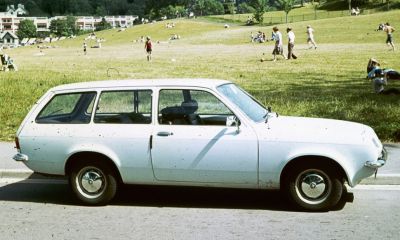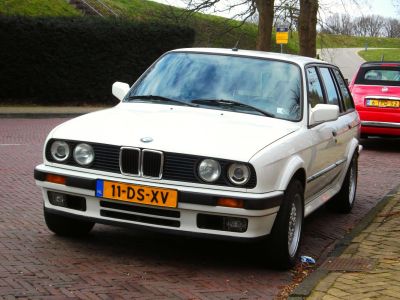 1973 Volkswagen Passat Variant (B1) Dimensions, Size & Specs
1973 Volkswagen Passat Variant (B1) Dimensions, Size & SpecsMeasurements of the 1973 Volkswagen Passat Variant, engineered for optimal performance and comfort
| Dimensions | |
|---|---|
| Length: | 4265 mm167.9 in14.0 ft |
| Width: | 1615 mm63.6 in5.3 ft |
| Height: | 1359 mm53.5 in4.5 ft |
| Ground Clearance: | 122 mm4.8 in0.4 ft |
| Trunk Capacity: | 699 liter24.7 cu ft |
| Trunk Capacity (Max): | 1461 liter51.6 cu ft |
| Weight Specifications | |
| Curb Weight: | 920-945 kg2028-2083 lbs |
| Maximal permitted Weight: | 1420 kg3131 lbs |
| Tire Specifications | |
| Rims Size: | 13-inch rims:
|
| Tire Size: |
|
The Volkswagen Passat Variant (B1), produced from 1973 to 1980, represents one of the early generations of the iconic Passat model line as a practical and versatile station wagon. This generation was tailored to drivers seeking a compact yet spacious vehicle suitable for families and cargo transport. With a length of 4265 mm (168 inches), a width of 1615 mm (63.6 inches), and a height of 1359 mm (53.5 inches), the Passat Variant (B1) maintained a balanced footprint, making it manageable in urban environments while offering significant interior space. The vehicle's curb weight ranges from 920 to 945 kg (2028 to 2084 lbs), depending on trim and equipment, with a maximum weight capacity reaching up to 1420 kg (3130 lbs). This weight profile reflects its sturdy build while maintaining good fuel efficiency relative to its era.
One of the standout features of the Passat Variant (B1) is its substantial luggage capacity. It offers 699 liters (24.7 cubic feet) of cargo space with the rear seats upright, which expands impressively to 1461 liters (51.6 cubic feet) when the rear seats are folded down. This flexibility made it an excellent choice for carrying larger loads, groceries, or luggage during long trips. The ride height or ground clearance is measured at 122 mm (4.8 inches), which provides adequate clearance for everyday road conditions while contributing to the wagon's stability and handling.
Equipped originally with 5J x 13 rims and tire sizes of 175/70 R13, the Passat Variant’s wheel setup was designed for reliability and comfort over European roads. The car's moderate width and low height enhanced aerodynamics for a vehicle of its class and time, while the overall dimensions reflect its purpose as a family-friendly station wagon.
In summary, the Volkswagen Passat Variant (B1) from 1973 to 1980 is a compact, practical station wagon whose size and load capacities made it a strong contender in its segment. Combining Volkswagen's hallmark build quality with well-thought-out interior flexibility, it remains a notable classic for enthusiasts and consumers interested in vintage vehicle dimensions and comparisons.
Discover the standout features that make the 1973 Volkswagen Passat Variant a leader in its class
Have a question? Please check our knowledgebase first.
The 1973 Volkswagen Passat Variant (B1) station wagon measures 4265 mm (167.9 inches) in length, 1615 mm (63.6 inches) in width, and stands 1359 mm (53.5 inches) tall. These compact dimensions contributed to its agile handling and ease of maneuvering in urban environments of its time.
The curb weight of the 1973 Volkswagen Passat Variant (B1) ranges between 920 and 945 kg (2028 to 2084 lbs). Its maximum permissible weight is 1420 kg (3130 lbs), which includes passengers and cargo. This relatively lightweight construction helped the vehicle achieve better fuel economy and nimble driving dynamics.
The Volkswagen Passat Variant from 1973 offers a generous luggage capacity of 699 liters (24.7 cubic feet) with rear seats in place. When the rear seats are folded down, this capacity expands substantially to 1461 liters (51.6 cubic feet), making it exceptionally practical for carrying large or bulky items for its era.
This Passat model features a ground clearance of 122 mm (4.8 inches), which is adequate for typical road conditions and urban driving environments it was designed for during the 1970s. While not suited for heavy off-road use, this clearance offers a good balance for comfort and handling on paved and moderately uneven surfaces.
The 1973 Volkswagen Passat Variant (B1) rides on 5J x 13 rims paired with 175/70 R13 tire sizes. These relatively narrow tires were characteristic of the period and supported efficient fuel economy while providing stable handling appropriate for a compact family station wagon.
Yes, with its length of 4265 mm (167.9 inches) and width of 1615 mm (63.6 inches), the 1973 Passat Variant (B1) comfortably fits within most standard residential garages, which typically measure about 2400 mm (94.5 inches) in width and 5400 mm (212.6 inches) in length. This makes it a practical choice for homeowners with typical garage space.
The Passat Variant (B1) was Volkswagen's first official Passat station wagon model, introduced in 1973. It replaced smaller and more compact sedans like the VW 1600, providing a larger and more spacious station wagon alternative. Compared to prior VW sedans, the B1 variant offered an extended length and increased cargo capacity, marking Volkswagen's transition into more practical family-oriented vehicles.
Compared with contemporaries such as the Ford Taunus Wagon or Opel Ascona Caravan, the Passat Variant (B1) was more compact in length and width, but it offered competitive cargo capacities—699 liters with seats up, expanding to 1461 liters when folded. This made it particularly appealing for buyers wanting practicality combined with easier maneuverability in urban settings compared to larger wagons.
The 1973 Volkswagen Passat Variant (B1) is a station wagon designed primarily for families and practical users needing both passenger space and cargo versatility. It targeted customers interested in a reliable, efficient car with an ample luggage area, suitable for everyday use, weekend trips, and small business utility.
The key benefits of the Passat Variant (B1) lie in its well-balanced dimensions, lightweight construction (920-945 kg / 2028-2084 lbs), and large cargo capacity (699 liters standard, 1461 liters with seats folded). Its compact exterior allowed for easy parking and driving in city environments, while the expansive luggage capacity gave it versatility uncommon in its category during the 1970s, making it a practical choice for families and businesses alike.
Discover similar sized cars.

| Production: | 1976-1985 |
|---|---|
| Model Year: | 1976 |
| Length: | 4188 mm164.9 in |
| Width: | 1570 mm61.8 in |
| Height: | 1323 mm52.1 in |

| Production: | 1987-1994 |
|---|---|
| Model Year: | 1988 |
| Length: | 4325 mm170.3 in |
| Width: | 1645 mm64.8 in |
| Height: | 1380 mm54.3 in |
